 As the time comes for me to start my first practicum, the time comes also for me to start really thinking about who I am and what persona, pedagogies, and teachings I want to bring in with me into the classroom. I realize that in my practicum I will get the opportunity to be able to observe and work with professionals and I can further my knowledge as an educator by experiencing new teaching pedagogies first hand. However, I still feel that I wish to find out more about myself as a person and as a teacher so I can bring these aspects into my class with confidence knowing what I am teaching is truly my style. I hope that no matter what my first practicum experience will allow me to grow as an educator and that my passion for education and educating children will be well received and beneficial for both my students and myself.
As the time comes for me to start my first practicum, the time comes also for me to start really thinking about who I am and what persona, pedagogies, and teachings I want to bring in with me into the classroom. I realize that in my practicum I will get the opportunity to be able to observe and work with professionals and I can further my knowledge as an educator by experiencing new teaching pedagogies first hand. However, I still feel that I wish to find out more about myself as a person and as a teacher so I can bring these aspects into my class with confidence knowing what I am teaching is truly my style. I hope that no matter what my first practicum experience will allow me to grow as an educator and that my passion for education and educating children will be well received and beneficial for both my students and myself.
Category: EPHE310A
 Although I am only in my second year of the education program from my past teaching experience and form my current pre-practicum work with my partnering teacher at a local middle school I have started to gather my own personal insight into what my teaching philosophy might be. What I believe in more than anything when it comes to being an educator is that teachers have to understand and acknowledge that every child contains their special types of “smarts”. Teachers cannot generalize students and their learning as every child acquires knowledge at their own rate and way. It is the students with their unique “smarts” that make us teachers rethink our personalized teaching views and make us grow as educators. I have gained this insight from observing and being a teacher-model to my pre-practicum students where this incredible experience has shown and taught me how different teachers manage various classes and lessons. Being in a classroom setting first hand has given me the chance to use the techniques I have observed while beginning to form my teaching style, a style that is a mix of the former favorited teachers of my past and the future teacher I wish to one day be.
Although I am only in my second year of the education program from my past teaching experience and form my current pre-practicum work with my partnering teacher at a local middle school I have started to gather my own personal insight into what my teaching philosophy might be. What I believe in more than anything when it comes to being an educator is that teachers have to understand and acknowledge that every child contains their special types of “smarts”. Teachers cannot generalize students and their learning as every child acquires knowledge at their own rate and way. It is the students with their unique “smarts” that make us teachers rethink our personalized teaching views and make us grow as educators. I have gained this insight from observing and being a teacher-model to my pre-practicum students where this incredible experience has shown and taught me how different teachers manage various classes and lessons. Being in a classroom setting first hand has given me the chance to use the techniques I have observed while beginning to form my teaching style, a style that is a mix of the former favorited teachers of my past and the future teacher I wish to one day be.
 Of my three academic years studying at the University of Victoria, I have taken a variety of courses that have guided me to be in the education program. This is a list of the following prerequisites I took and needed to be apart of the elementary education program and also the current and future courses I am registered in. The vast selection of courses ranges from all first-year science courses to my passionate education classes, each class valuable in its own way.
Of my three academic years studying at the University of Victoria, I have taken a variety of courses that have guided me to be in the education program. This is a list of the following prerequisites I took and needed to be apart of the elementary education program and also the current and future courses I am registered in. The vast selection of courses ranges from all first-year science courses to my passionate education classes, each class valuable in its own way.
Elementary Education:
EDCI 250: Elementary Field Experience Seminar I
EDCI 302: Literacy and Language in Elementary or Middle School
EDCI 305A: Drama Education as a Medium for Learning I
EDCI 306A: Music in the Elementary Classroom
EDCI 336: Technology Innovation in Education
EPHE 310: Physical Education for General Classroom Teachers I
ED-D 301: Learners and Learning Environment
EDCI 300: Mathematical Processes
EDCI 303: Historical and Philosophical Foundations of Canadian Education
EDCI 307A: Arts in the Elementary Classroom I
EPHE 310: Physical Education for General Classroom Teachers II
English:
ENGL 135: Academic Reading and Writing
ENGL 146: The Literature of Our Era
Science:
CHEM 101: Properties of Material
CHEM 102: Environmental and Physical Chemistry
PHYS 102A: General Physics I
PHYS 102B: General Physics II
BIOL 186: Physiology and Cell Biology
Canadian studies:
SOCI 103: Canadian Society
CS 102: Introduction to Canadian Contemporary Issues
Math:
Math 109: Introduction to Calculus
Math 161: Mathematics for Elementary School Teachers I
Math 162: Mathematics for Elementary School Teachers II
Electives:
EPHE 143: Multidisciplinary Foundations of Physical Activity
PHIL 201: Critical Thinking
PSYC 100A: Introductory Psychology I
PSYC 100B: Introductory Psychology II
HLTH 251: Healthy Sexuality
Below is an example of an entire lesson plan, more specifically a lesson plan for a cartwheel lesson of a greater gymnastic unit. This lesson plan includes an introduction, learning objectives for the students (the psychomotor, cognitive, and affective aspects), a warm-up game, a stretching component, a demonstration/task analysis, the body of the lesson, a cumulative activity, and a cooldown. A proper lesson plan should be detailed enough so a teacher on call or anyone reading this would be able to have enough information to prepare and perform the lesson asked.
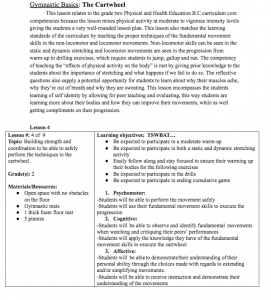

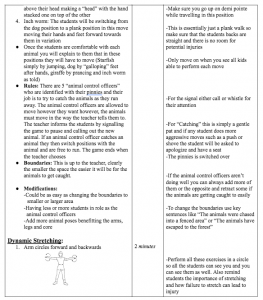
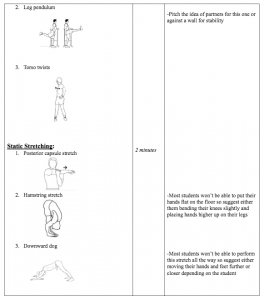
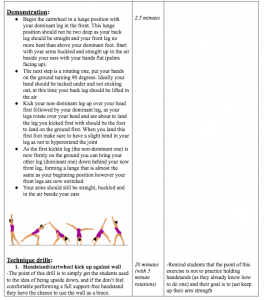
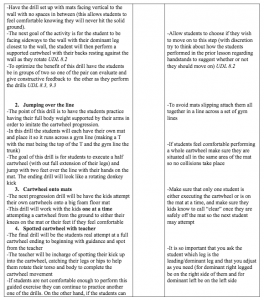
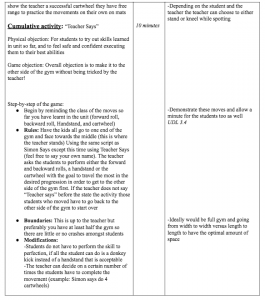
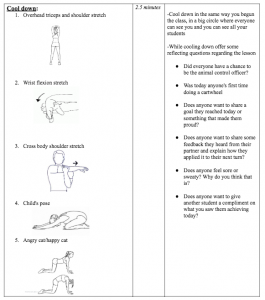
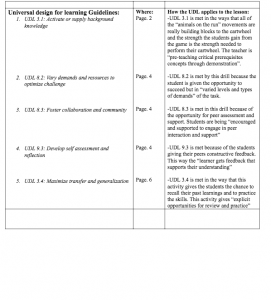
Being apart of the education program, you get a lot of opportunities to experience teaching opportunities whether it be in front of peers or by going out into the field and teaching children. I go the opportunity to teach a grade 7/8 dance club practice with peer candidate teachers and it was our job to create an appropriate lesson plan that we could use for our teaching. The lesson plan we created is simple, it is an across the floor combination that combines 3 main skills of dance, turning, footwork and flexibility. We chose to create a very diverse assortment of exercises because of the skill level of the class. All of the students apart of the club were beginners and by branching out from usual combinations we were able to appeal to the skills of more learners. Alike the other lesson plans we had a warm-up activity, the demonstrations/task analysis of the combinations, our body of the lesson which was the learning of the combinations, the cumulative activity of participating in the across-the-floor combinations and finally our cool down.
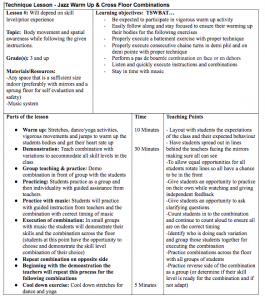
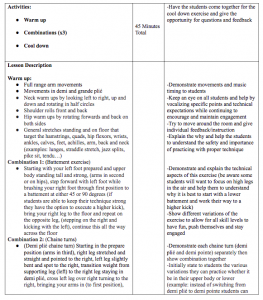
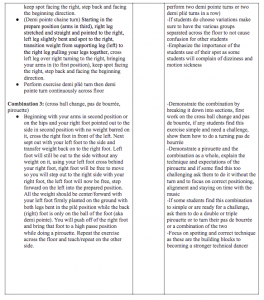

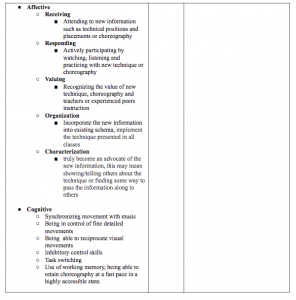
The next part of a lesson after the warm-up is called the “body” of a lesson. The body defines the portion of the lesson where the majority of instruction and learning of a specific task takes place. The task that is learned in this section is usually a skill from a bigger unit, for example in the lesson plan below the students were learning the skill setting for their volleyball unit.
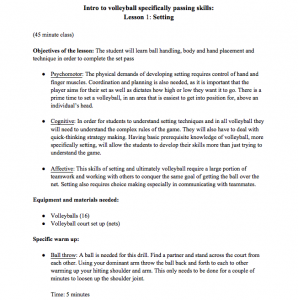

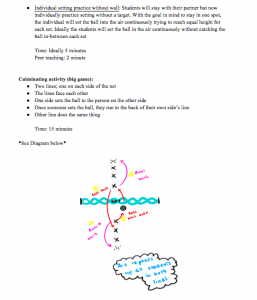

Waking up for an 8:30 class can be challenging, waking up for an 8:30 class to the pouring rain when you know you’re about to spend the whole of the class period pulling plants is even more difficult. However, this is the view of a young adult, not one of a soon to be an educator. In the eyes of a future teacher, this experience was one that I hope all my students get to experience. Volunteering with the Greater Victoria Green Team participating in a eco-restoration session was a very valuable opportunity for me. Even though it confused me the point of pulling the plants when I thought the point of restoring the environment was conserving its species, I learned from the experience that the plants we were pulling were an invasive species that had actually begun to destruct the nature around it. It is information like this that I wish to teach my future students, and for us as a class to participate in the same outdoor educational sessions.
I grew up in a small rural community surrounded by forests, agriculture and the ocean where a main aspect of the culture was to appreciate and be in nature. In high school, I was part of an integrated outdoor education program where I was challenged personally, physically and mentally in the aspects of my school work and in the outdoor excursions we got to take part in. It is one of my goals as a teacher in the future to allow my students the same outdoor educational opportunities that I got to be apart of as I wish my students to feel the same love for nature as I have.
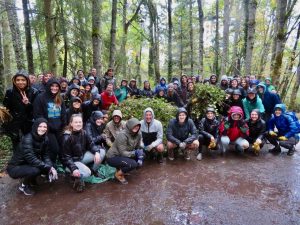
All the volunteers from the eco-restoration volunteer session at Mystic Vale
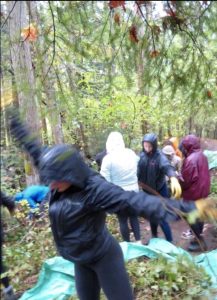
Me practicing my tossing skills
I grew up with an ocean in my backyard. Literally. My child consisted of summers of waking up at 6 am to “save” the crabs and starfish from drying out in the sun and/or getting eaten by seagulls, sailing across the straight to the small provincial park island “Mitlenatch” and exploring its shores, paddle boarding, kayaking and if we were brave enough swimming. Needless to say, I love the water and it has always been a source of both comfort and adventure for me.
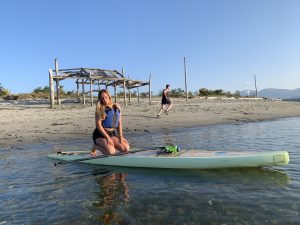
From what you have read about myself already you will know that I have spent my last three summers instructing a kids kayaking camp where I teach my students water safety, basic kayaking strokes, paddle boarding, and canoeing. To be in this position I must be on the instructor platform of Paddle Canada.

I am a certified Paddle Canada Level one, instructor of three years, earning this title by participating in a week-long intensive. With my skills as a paddler throughout these three years of teaching, I have also gained valuable skills as an educator. As the guardian of these camps, I have learned the skills of leadership. Being the adult in charge of the lives of these children has taught me problem-solving. While on the water surrounded by a dozen children ages 7-14 the unpredictable can occur at any moment, one must be quick-witted, flexible and innovative and be able to embrace the challenge of changing conditions at all times. I have also learned the importance of setting a professional relationship between student and teacher. On an on-water classroom where the risk level is drastic, there is a time and a place for when the “friend” must be replaced by the “authoritarian” and it is up to the teacher to be able to switch roles and have his or her students respect and listen to the change. This is one of the most valuable teaching principles I learned from all my work on the water.
For the first assignment of the class, we focused on the elements of a physical education lesson plan, the first portion of the lesson being the warmup. The main aspects of the warm-up that we learned about were the importance of them in elementary physical education. The main point of warming up before performing physical exercise is to increase the muscle and body temperature, by doing this and allowing your muscles to get warmer oxygen becomes more available to your muscles, allowing them to contract and relax more easily. Another important part of warming up is that it helps reduce the chance of injury by helping improve muscle elasticity. Warm-ups are high-intensity activities that will introduce or be related to the body of the lesson in some way.
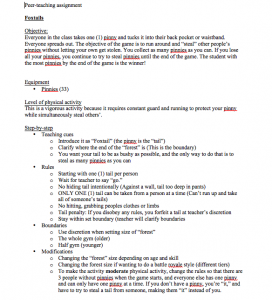

Hello there and welcome to my teaching career in the physical education world! In this section of my blog, I hope you get to know me a little bit more and delve into the work I have been doing in my other classes throughout my second year as part of the Uvic Bachelors of Education program. You can look forward to reading about my daily experiences in my EPHE 310 classes, looking at some assignments I have completed so far, and so much more! I hope you find this part of my blog as an interest grabber to you and that it might inspire you to wander into the world of physical education and learn something you didn’t know before!
Recent Comments